In 2012, a tiny fragment of papyrus sent shockwaves through the world of religion and academia. Written in ancient Coptic, the text contained a startling phrase: “Jesus said to them, my wife…” This discovery reignited debates about whether Jesus was married—a question that has intrigued scholars, believers, and skeptics alike for centuries. Was this evidence of a hidden truth, or simply a clever forgery? Let’s dive into the story behind this controversial artifact and explore its implications.
What Is the “Gospel of Jesus’ Wife”?
The fragment, often referred to as the Gospel of Jesus’ Wife, is no larger than a business card—just 1.6 by 3.2 inches. On one side, it contains eight lines of faded black ink, legible only under magnification. Below the line mentioning Jesus’ wife, another provocative statement reads: “She will be able to be my disciple.”

This discovery was made public by Karen King, a professor at Harvard Divinity School, during the International Congress of Coptic Studies in Rome. According to King, the text doesn’t definitively prove that Jesus had a wife but raises questions about how early Christians viewed marriage, celibacy, and women’s roles in the church.
Why Is It So Controversial?
The idea of Jesus being married challenges centuries of Christian tradition. For most denominations, Jesus is portrayed as celibate, focusing solely on his spiritual mission. However, some early Christian groups believed he might have been married, possibly to Mary Magdalene, a close companion mentioned in the Bible.
The fragment also touches on another contentious issue: the role of women in early Christianity. By suggesting that Jesus could refer to a woman as his disciple, the text challenges traditional views that excluded women from leadership roles. As King explains, “The main topic of the fragment is to affirm that women who are mothers and wives can be disciples of Jesus.”
Is the Fragment Authentic?
When the papyrus first surfaced, skepticism abounded. Critics pointed out grammatical errors, poor handwriting, and the lack of clear provenance (its origin remains unknown). Even the Vatican’s newspaper dismissed it as a forgery.
However, scientific analysis conducted by experts at Columbia University, Harvard University, and MIT suggests otherwise. Radiocarbon dating places the papyrus between the sixth and ninth centuries, with possible origins as early as the second century CE. Micro-Raman spectroscopy confirmed that the ink composition aligns with other ancient texts.
“No evidence of modern fabrication (‘forgery’) was found,” stated the Harvard Divinity School. While these findings support the papyrus’s authenticity, they don’t confirm the historical accuracy of its claims.
Who Wrote It—and Why Does It Matter?
The author of the fragment remains anonymous, as does the collector who provided it to Karen King. Whoever wrote it likely lived centuries after Jesus’ death, meaning they wouldn’t have known him personally. The crude appearance and grammatical mistakes suggest the writer had limited education, which adds to the mystery.
Despite its late date, the text sheds light on theological debates within early Christianity. During this period, followers argued over issues like celibacy versus marriage and the inclusion of women in religious leadership. The mention of Jesus’ wife may reflect these discussions rather than historical fact.
Criticisms and Counterarguments
Not everyone accepts the fragment’s legitimacy. Leo Depuydt, an Egyptology professor at Brown University, argues that the document is a modern creation. He highlights grammatical flaws and notes that the phrase “my wife” appears unusually bold compared to other ancient Coptic texts.
King counters these criticisms, explaining that blotting ink was common in ancient manuscripts. She also points out that darker letters appear below the contested phrase, supporting its antiquity.
What Does This Mean for Christianity?
While the Gospel of Jesus’ Wife doesn’t provide definitive proof of Jesus’ marital status, it invites us to reconsider what we think we know about early Christianity. Could Jesus have valued family life alongside spiritual devotion? Could women have played a more prominent role in his ministry than previously acknowledged?
These questions aren’t just academic—they strike at the heart of modern debates about gender equality and religious interpretation. For example, if Jesus supported married clergy, it could influence contemporary discussions about celibacy in Catholicism.
Conclusion
The Gospel of Jesus’ Wife remains a polarizing artifact, sparking both fascination and controversy. Whether authentic or not, it underscores the complexity of interpreting ancient texts and understanding their cultural contexts.
As Karen King aptly puts it, “This gospel fragment provides a reason to reconsider what we thought we knew by asking what the role claims of Jesus’s marital status played historically in early Christian controversies over marriage, celibacy, and family.”
So, did Jesus have a wife? We may never know for sure. But the mere possibility reminds us that history is rarely as straightforward as it seems—and sometimes, even the smallest scraps of paper can challenge our deepest beliefs.
What do you think? Share your thoughts below!
Disclaimer: The views expressed here do not necessarily reflect the opinions of our website. This article is presented for informational and discussion purposes, and we encourage readers to engage with the material thoughtfully and respectfully. Reader discretion is advised.
Sources:

